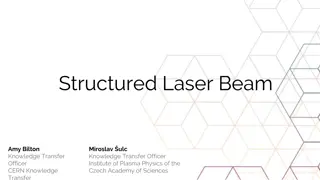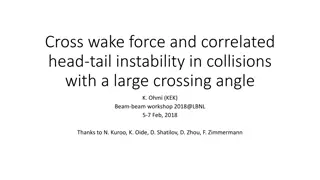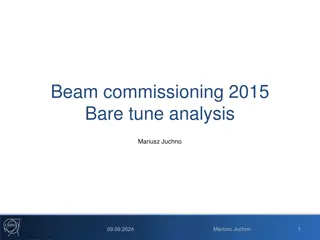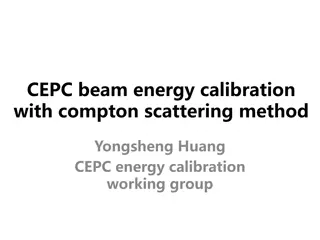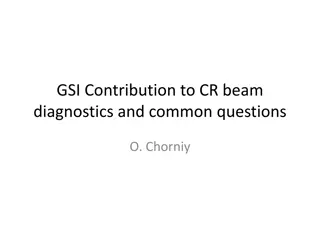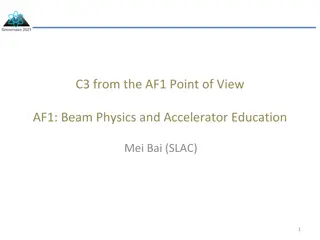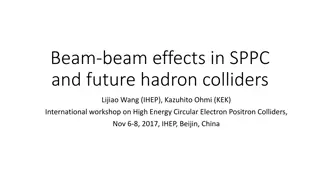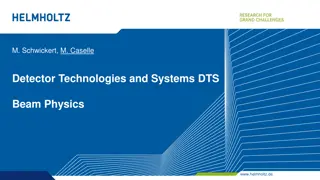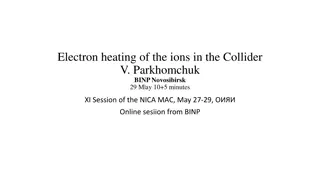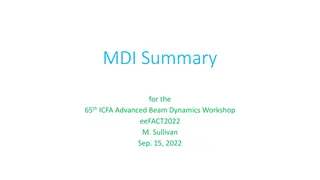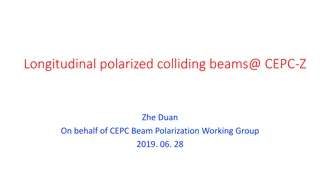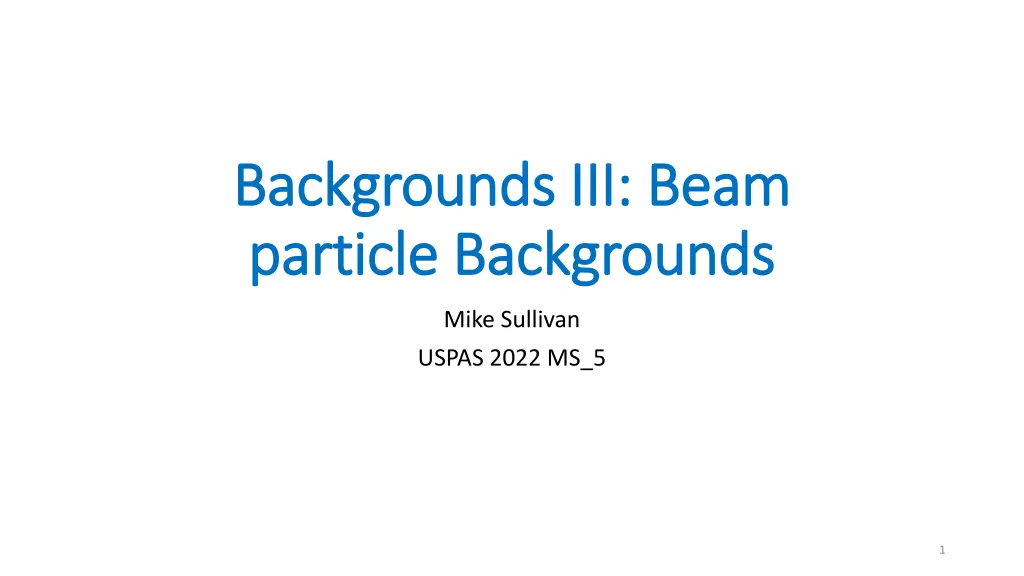
Understanding Beam-Particle Interactions in Accelerators
Explore the various backgrounds arising from beam-particle interactions in accelerators, including gas molecule interactions, collision-related backgrounds, and instability issues. Learn about Coulomb scattering, Beam-gas Bremsstrahlung, and how modern accelerator designs manage ring gas pressure for optimal performance.
Download Presentation

Please find below an Image/Link to download the presentation.
The content on the website is provided AS IS for your information and personal use only. It may not be sold, licensed, or shared on other websites without obtaining consent from the author. If you encounter any issues during the download, it is possible that the publisher has removed the file from their server.
You are allowed to download the files provided on this website for personal or commercial use, subject to the condition that they are used lawfully. All files are the property of their respective owners.
The content on the website is provided AS IS for your information and personal use only. It may not be sold, licensed, or shared on other websites without obtaining consent from the author.
E N D
Presentation Transcript
Backgrounds III: Beam Backgrounds III: Beam particle Backgrounds particle Backgrounds Mike Sullivan USPAS 2022 MS_5 1
Beam particle backgrounds Beam particle backgrounds Now we discuss the other main backgrounds of detectors Those that result from errant beam particles First there is the interaction of a beam particle with a gas molecule Then there are collision related backgrounds Instability backgrounds can result when the accelerator encounters a region in parameter space where one or more beam bunches go unstable or where an interaction blows up a beam bunch An unbalanced collision can blow up one beam while the other beam stays very small 2
Beam Beam- -gas backgrounds gas backgrounds There are two major backgrounds from beam-gas interactions in an electron ring Coulomb scattering Beam-gas Bremsstrahlung (BGB) Coulomb scattering is elastic and the interaction changes the direction of the beam particle The energy of the beam particle is unchanged which means that the scattered beam particle has a much better chance of traveling farther around the ring and perhaps generating background in the detector. Thus, we need to track the scattered particles from this interaction much farther around the ring and perhaps even more than once around the ring BGB is the inelastic form of Coulomb scattering. In this case, a photon is emitted and the photon takes some of the beam particle energy. The loss of energy for the beam particle means that this particle usually does not travel very far from the interaction before it is swept out of the beam pipe (usually by a bend magnet). The photon also will not go much farther than the next bend magnet before it too crashes into the beam pipe Coulomb scattering (elastic) BGB scattering (inelastic) 3
Beam Beam- -gas interactions (2) gas interactions (2) The beam-gas interactions populate the non-gaussian beam tail distributions The cross-section for both of these interactions gets very large for small angle scattering If the gas molecule is neutral, then the electron (or positron) has to get inside the outer electron shells. Even so, the interaction may still be a low angle scattering event. Of course, the rate for these interactions is directly related to the gas pressure in the ring 4
Ring gas pressure Ring gas pressure Modern accelerator designs strive to achieve as low a ring gas pressure as possible that is, within reason budget-wise Experience has shown that beam lifetimes in stored rings are quite good when the average gas pressure is close to 1 nTorr = 1 10 9 Torr (= 1.3 10 7 Pa) 760 Torr = 1 Atm = 1 Bar = 101,325 Pa One nTorr can be achieved using modern vacuum assembly and cleaning techniques However, when a beam of electrons (or positrons) is first stored in a ring, the SR generated by the beam will strike various sections of the vacuum chamber with various intensities This leads us to the next topic of scrubbing 5
Ring gas pressure and scrubbing Ring gas pressure and scrubbing Vacuum sections are manufactured, cleaned and assembled in a 1 atm environment This means that gas molecules can and do become imbedded in the vacuum walls. There will be places between the crystal boundaries for instance. When SR in the form of x-rays strikes the vacuum wall, the x-rays can and do penetrate some distance into the wall This incident energy can then dislodge gas molecules (both from the surface as well as inside the metal) This extra gas will raise the pressure inside the vacuum chamber and the pumping system will have to pump out this new gas Essentially all electron storage rings go through this process 6
Vacuum scrubbing Vacuum scrubbing The first time that beam is stored in a ring this process starts up, but it may not be very noticeable as the initial beam currents are not very high Initially, only one bunch is stored and then only a few bunches are stored Gradually, as more bunches get stored and as the total beam current increases the outgassing can get to be very high The average gas pressure in the ring can increase by as much as a factor of 100 or more The beam lifetime can be affected to such an extent that one is not able to increase the beam current the injection rate matches the loss rate Usually, if the detector is online, the detector backgrounds will be too high, and one will have to either close down ring collimators or lower the beam current Closing the collimators will further shorten the beam lifetime which also forces the beam current to come down 7
Scrubbing mode Scrubbing mode The accelerator is now in scrubbing mode The beam currents are limited by beam lifetime (or detector background) due to the increase in gas pressure from the SR x-ray photons striking the vacuum chamber all around the ring and dislodging imbedded gas molecules This continues until the rate of gas molecules coming out of the beam pipe wall finally diminishes and backgrounds go down and the beam lifetime increases which means more beam current can be stored As more beam current is stored then two things happen The SR produces more photons in the high-energy tail of the photon distribution and these higher energy photons can penetrate deeper into the material dislodging more gas molecules The main strike point of the SR cleans up quickly, but the rest of the entire beam pipe also receives scattered photons, and these scattered photons must scrub the rest of the beam pipe. This rate of clean up is consequently much slower for these parts of the beam pipe. Once the desired beam current is reached (or nearly reached) then the scrubbing continues but the backgrounds should gradually go down and the beam lifetime should gradually increase as the vacuum continues to improve 8
Scrubbing time Scrubbing time Most storage rings before the B-factories did not have a very long scrubbing time because the beam currents were not very high This includes light source rings The machines all did have some scrubbing time but in many cases it was not more than a few weeks The B-factories had the first mutli-ampere beams, and they found that beam pipe scrubbing took several months of steady running There was some uncertainty about whether or not the scrubbing rate and vacuum improvement would continue beyond the then upper limit of 100 Amp-hrs of running time The B-factories have shown that the vacuum improvement continues out to at least 5000 Amp-hrs 9
Vacuum improvement with scrubbing Vacuum improvement with scrubbing Here is a plot of the dynamic vacuum pressure (left side of plot) vs running time in Amp-hrs (bottom) The right side of the plot is the function which is a measure of the number of gas molecules released per incident photon This plot argues that a ring needs at least 1000 Amp-hrs of scrubbing before a 1 Amp beam can experience a 1 nTorr vacuum This plot is for a Distributed Ion Pump (DIP) region of the HER. A region of very good pumping. Plot made by Uli Wienands for the PEP-II HER ring 10
BGB background minimization BGB background minimization As we stated earlier, the outgoing particles (off-energy beam particle and gamma ray) from a BGB interaction usually do not travel very far around the ring before they crash into the beam pipe So, in order to minimize this background, we need to have a very good vacuum pressure between the IP and the last bend magnet This also means that good pumping should be located near the strike points of the SR coming from the last bend magnet as well as any further upstream SR sources that enter into this region between the last bend and the IP Simulations can guide this study We need a BGB generator and a synchrotron radiation simulator Just making a geometric drawing of this region can be very helpful in looking for the SR strike region(s) 11
Coulomb scattering minimization Coulomb scattering minimization This background is a bit harder to control The scattered beam particle can (and usually does) travel farther around the ring and can even travel more than once around the entire ring It takes many turns (usually dozens) before the scattered beam particle drifts back into the main core A good collimation scheme around the entire ring is the best way to control this background Both of the beam-gas scattering backgrounds of course can be controlled by maintaining a very good vacuum around the entire ring Here again we need a generator for the Coulomb scatter as well as particle tracking code to follow the scattered particle 12
Summary Summary Beam-gas interactions are the primary background source for the detector during commissioning and early running This background usually limits the initial beam currents and also determines the beam current increase rate If too much current is put into the ring the lifetime will become too short and the detector backgrounds will become too high The non-gaussian beam-tails become too high and generate too much background As the vacuum improves these backgrounds decrease but other background sources may surface (next topic) 13



